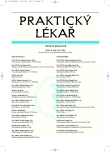Auditory system and its disturbances
Authors:
F. Koukolík
Authors‘ workplace:
Primář: MUDr. František Koukolík DrSc.
; Národní referenční laboratoř prionových chorob
; Fakultní Thomayerova nemocnice s poliklinikou, Praha
; Oddělení patologie a molekulární medicíny
Published in:
Prakt. Lék. 2008; 88(4): 204-207
Category:
Various Specialization
Overview
Functional neuroanatomy of the central auditory system is more complicated than the functional neuroanatomy of the visual system. Neuronal and mental representations of the acoustic information are formed by extraction of its statistical properties and by construction of acoustic objects. The mapping of the acoustic cortex discovered root, core, belt and parabelt zones and their projections to other cortical areas. The acoustic systems WHAT, WHERE and WHEN are shortly described. Central acoustic disorders are word deafness, acoustic agnosia and cortical deafness.
Key words:
acoustic system, functional neuroanatomy, word deafness, acoustic agnosia, cortical deafness.
Sources
1. Ahveninen, J., Jääskeläinen, I.O., Rai, J.T. et al. Task modulated „what“ and „where“ pathways in human auditory cortex. Proc. Natl. Acad. Sci. 2006, 103, p. 1460-1463.
2. Barrett, D.J., Hall, D.A. Response for „what“ and „where“ in human non-primary auditory cortex. Neuroimage 2006, 32, p. 968-977.
3. De Santis, L., Clarke, S., Murray, M.M. Automatic and intrinsic auditory „what“ and „where“ processing in human revealed by electrical neuroimaging. Cerebral Cortex 2007, 17, p. 9-17.
4. Fullerton, B.C., Pandya, D.N. Architectonic analysis of the auditory-related areas of the superior temporal region in human brain. J. Comp. Neurol. 2007, 504, p. 470-498.
5. Griffith, T.D., Büchel, Ch., Frackowiak, R. S.J. et al. Analysis of temporal structure in sound by the human brain. Nature Neuroscience 1998, 1, p. 422-427.
6. Guéguin, M., Le Bouquin-Jeannés, R., Faucon, G. et al. Evidence of functional connectivity between auditory cortical areas revealed by amplitude modulation sound processing. Cerebral Cortex 2007, 17, p. 304-313.
7. Hagen, E.H., Brynant, G.A. Music and dance as a coalition signaling system. Hum. Nat. 2003,14, p. 21-51.
8. Johnsrude, I.S., Penhune, V.B., Zattore, R.J. Functional specificity in the right human auditory cortex for perceiving pitch direction. Brain 2000, 123, p. 155-163.
9. Koukolík, F. Sociální mozek. Praha: Karolinum 2006. ISBN 80-246 - 1242-9, p.187-195
10. Langers, D.R., Backes, W.H., VanDijk, P. Representation and tonotopy in primary versus secondary auditory cortex. Neuroimage 2007, 34, p. 264-273.
11. Lehhman, C., Herdener, M., Schneider, P. et al. Dissociated lateralization of transient and sustained blood oxygen level-dependent signal components in human auditory cortex. Neuroimage 2007, 34, p. 1637-1642.
12. Lewis, J.W., Wightman, F.L., Brefczynski, J. et al. Human brain regions in recognizing environmental sounds. Cerebral Cortex 2004, 14, p. 1008-1021.
13. Miller, GF. The mating mind. New York: Doubleday, 2000.
14. Musiek, F.E., Baran, J.A., Shinn, J.B. et al. Central deafness: an audiological case study. Int. J. Audiology 2007, 46, p. 433 -441.
15. Pollmann, S., Lepsien, J., Hughdal, K. et al. Auditory target detection in dichotic listening involves the orbitofrontal nad hippocampal paralimbic belts. Cerebral Cortex 2004, 14, p. 903-913.
16. Riley, J.A., Cogan, G.B. A two mechanism model of pure word deafness. In: University of Maryland working papers in linguistics, ed. Omaki, J. et al. 2007, p. 201-221.
17. Sweet, R.A., Pierri, J.N., Auh, S. et al. Reduced pyramidal cell somal volume in auditory association cortex of subjects with schizophrenia. Neuropsychopharmacology 2003, 28, p. 599-609.
18. Weeks, R., Horwitz, B., Aziz-Sultan A. et al. A positron emission tomographic study of auditory localization in the congenitally blind. J. Neuroscience 2000, 20, p. 2654-2672.
19. Zattore, R.J., Penhune, V.B. Spatial localization after excision of human auditory cortex. J. Neuroscience 2001, 21, p. 6321-6328.
Labels
General practitioner for children and adolescents General practitioner for adultsArticle was published in
General Practitioner

2008 Issue 4
- Metamizole at a Glance and in Practice – Effective Non-Opioid Analgesic for All Ages
- Memantine in Dementia Therapy – Current Findings and Possible Future Applications
- Advances in the Treatment of Myasthenia Gravis on the Horizon
- Hope Awakens with Early Diagnosis of Parkinson's Disease Based on Skin Odor
- Possibilities of Using Metamizole in the Treatment of Acute Primary Headaches
Most read in this issue
- Extraintestinal symptoms of coeliac disease
- Sarcoidosis- a systemic disease. What is new?
- Triplane fracture of distal tibia in children
- Fatal abscessing pneumonia caused by oxacillin-resistant Staphylococcus aureus producing Panton-Valentine leukocidin
